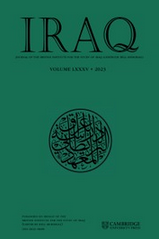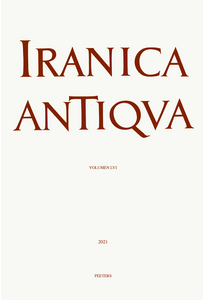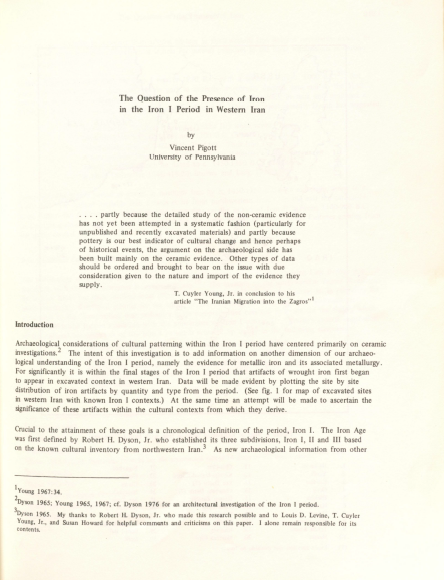Publications so far
0
| 1. |  | Amelirad, Sheler; Razmpoush, Abbas; Khanmohamadi, Behroz: Kani Charmou, an Iron Age II graveyard. In: Iraq, vol. 85, pp. 49-71, 2024. (Type: Journal Article | Abstract | Links | BibTeX)@article{nokey,Examining the archaeological findings within the Mannaean kingdom, a significant association with Assyria emerges, highlighting these regions’ interconnectedness. The influence of both Urartian and Assyrian cultures on the Mannaean people becomes evident, indicating a shared cultural heritage or intimate exchanges among these cultures. Notably, the Kani Charmou graveyard in Mannaea serves as a compelling example, revealing a rich assortment of artifacts that parallel those discovered in Ziwiye, a renowned archaeological site in the region. These diverse grave goods unequivocally demonstrate the existence of a robust trade and exchange network between Mannaea and its neighbouring western counterpart, Assyria, and the profound impact of Assyrian culture on Mannaean society. This connection is also evident in religious practices, which show similarities. Through stylistic analysis and the identification of parallels in metal vessels, glazed jars, and a cylinder seal, the proposed dating of the Kani Charmou graveyard aligns with the Iron Age II period. |
| 2. |  | Amelirad, Sheler; Mohajerynezhad, Abdolrezer; Javidkhah, Masoume: A Report on the Excavation at the Mala Mcha Graveyard, Kurdistan, Iran. In: Iran, vol. 55, iss. 2, pp. 171-207, 2017. (Type: Journal Article | Abstract | Links | BibTeX)@article{nokey,The Mala Mcha graveyard is located in Iranian Kurdistan, near the ancient Mannaean site of Ziwiya. Abdolreza Mohajerynezhad and Rasol Oshtodan conducted rescue excavations at Mala Mcha in 2012, and 16 graves were uncovered. Although most of the graves had been plundered by tomb robbers the tomb structures, and especially the grave-goods that remained, suggest an Iron Age III date and close relations with neighbouring sites such as Ziwiye, Qalaichi and Changbar. Most of the graves were covered with large flat slabs and contained one, two or three burials, the exception being tomb no. 7 with 14 burials. |
| 3. |  | Amelirad, Sheler; Overlaet, Bruno; Haerinck, Ernie: The Iron Age “Zagros Graveyard” Near Sanandaj (Iranian Kurdistan): Preliminary Report on the First Season. In: Iranica Antiqua, vol. 47, pp. 41-99, 2012. (Type: Journal Article | Abstract | Links | BibTeX)@article{nokey,An Iron Age graveyard, for the most part dating from the 8th - 7th century BC, was accidentally discovered in 2008 during road works near Sanandaj, Iranian Kurdistan. Rescue excavations were conducted by the Cultural Heritage Department in Sanandaj. The present contribution reports on these first excavations during which more than 20 graves were discovered in two squares and a trench. A selection of the graves and the burial goods are discussed. |
| 4. | Pigott, Vincent Charles: Ahan. In: Encyclopaedia Iranica
, vol. 1, pp. 624-633, Encyclopaedia Iranica Foundation. Inc., 1987. (Type: Book Chapter | Links | BibTeX)@inbook{nokey, | |
| 5. |  | Pigott, Vincent Charles: The question of the presence of iron in the iron I period in Western Iran. In: Bibliotheca Mesopotamica, vol. 7, pp. 210-234, 1977. (Type: Journal Article | Abstract | BibTeX)@article{nokey,Archaeological considerations of cultural patterning within the Iron I period have centered primarily on ceramic investigations. The intent of this investigation is to add information on another dimension of our archaeological understanding of the Iron I period, namely the evidence for metallic iron and its associated metallurgy. For significantly it is within the final stages of the lron I period that artifacts of wrought iron first began to appear in excavated context in westem Iran. Data will be made evident by plotting the site by site distribution of iron artifacts by quantity and type from the period. (See fig. 1 for map of excavated sites in westem Iran with known Iran I contexts.) At the same time an attempt will be made to ascertain the significance of these artifacts within the cultural contexts from which they derive. |
| 6. | Pigott, Vincent Charles: The Question of the Presence of Iron in the Iron I Period in Western Iran. In: Levine, Louis D. (Ed.): Mountains and Lowlands. Essays in the Archaeology of Greater Mesopotamia
, pp. 209-234, Undena Publications, 1977. (Type: Book Section | BibTeX)@incollection{nokey, | |
| 7. | Schumacher, Erich: Eisenschwerter mit Maskenzier aus Luristan. In: Bonner Hefte zur Vorgeschichte, no. 4, pp. 97-108, 1973. (Type: Journal Article | BibTeX)@article{nokey, | |
| 8. | Maxwell-Hyslop, Rachel; Hodges, H. W. M.: Three iron swords from Luristan. In: Iraq, iss. 28, no. 2, pp. 164-176, 1966. (Type: Journal Article | Abstract | Links | BibTeX)@article{nokey,"None of the three swords to be discussed has a precise provenance. The first sword is the property of R. T. Clough Esq., and was kindly lent to us for examination; the second was bought through dealers and is now the property of the Institute of Archaeology, University of London; the third was kindly given to the Institute of Archaeology by G. Nazar Esq., to whom we would like here to record our sincere thanks. Our purpose will be to discuss the techniques by which these swords were made; to consider their relationships with one another, and to suggest a chronological framework which can be used for dating similar Iranian iron weapons. Although heavily corroded this sword is essentially complete insofar as the metallic part is concerned, measuring 52·5 cms. from pommel to point. The blade can best be described as having the outline of a willow-leaf, with its maximum width, 3 cms., rather more than a third of its length from the hilt. Down the centre of the blade on both faces is a wide flattened mid-rib, tapering at the point." | |
| 9. | Naumann, Friedrich Karl: Untersuchung eines eisernen luristanischen Kurzschwertes. In: Archiv für das Eisenhüttenwesen, vol. 28, iss. 9, pp. 575-581, 1957. (Type: Journal Article | Links | BibTeX)@article{nokey, | |
| 10. |  | Brown, T. B.: Ancient Mining and Metallurgy Committee, Second Report: Iron Objects from Azarbaijan. In: Man, Royal Anthropological Institute of Great Britain and Ireland, vol. 50, no. 3, pp. 7-9, 1950. (Type: Journal Article | Links | BibTeX)@article{nokey, |
| 11. | Böhne, E.: Die Eisenindustrie Masenderans. In: Stahl und Eisen, vol. 48, pp. 1577-1580, 1928. (Type: Journal Article | BibTeX)@article{nokey, |
2024 |
|
 | Amelirad, Sheler; Razmpoush, Abbas; Khanmohamadi, Behroz: Kani Charmou, an Iron Age II graveyard. In: Iraq, vol. 85, pp. 49-71, 2024. (Type: Journal Article | Abstract | Links | BibTeX | Tags: Iron, Iron Age, Kurdistan, Zagros, Zagros Highlands)@article{nokey,Examining the archaeological findings within the Mannaean kingdom, a significant association with Assyria emerges, highlighting these regions’ interconnectedness. The influence of both Urartian and Assyrian cultures on the Mannaean people becomes evident, indicating a shared cultural heritage or intimate exchanges among these cultures. Notably, the Kani Charmou graveyard in Mannaea serves as a compelling example, revealing a rich assortment of artifacts that parallel those discovered in Ziwiye, a renowned archaeological site in the region. These diverse grave goods unequivocally demonstrate the existence of a robust trade and exchange network between Mannaea and its neighbouring western counterpart, Assyria, and the profound impact of Assyrian culture on Mannaean society. This connection is also evident in religious practices, which show similarities. Through stylistic analysis and the identification of parallels in metal vessels, glazed jars, and a cylinder seal, the proposed dating of the Kani Charmou graveyard aligns with the Iron Age II period. |
2017 |
|
 | Amelirad, Sheler; Mohajerynezhad, Abdolrezer; Javidkhah, Masoume: A Report on the Excavation at the Mala Mcha Graveyard, Kurdistan, Iran. In: Iran, vol. 55, iss. 2, pp. 171-207, 2017. (Type: Journal Article | Abstract | Links | BibTeX | Tags: Chronology, Excavation, Iron, Iron Age, Kurdistan, Zagros Highlands)@article{nokey,The Mala Mcha graveyard is located in Iranian Kurdistan, near the ancient Mannaean site of Ziwiya. Abdolreza Mohajerynezhad and Rasol Oshtodan conducted rescue excavations at Mala Mcha in 2012, and 16 graves were uncovered. Although most of the graves had been plundered by tomb robbers the tomb structures, and especially the grave-goods that remained, suggest an Iron Age III date and close relations with neighbouring sites such as Ziwiye, Qalaichi and Changbar. Most of the graves were covered with large flat slabs and contained one, two or three burials, the exception being tomb no. 7 with 14 burials. |
2012 |
|
 | Amelirad, Sheler; Overlaet, Bruno; Haerinck, Ernie: The Iron Age “Zagros Graveyard” Near Sanandaj (Iranian Kurdistan): Preliminary Report on the First Season. In: Iranica Antiqua, vol. 47, pp. 41-99, 2012. (Type: Journal Article | Abstract | Links | BibTeX | Tags: Ceramics, Chronology, Excavation, Iron, Iron Age, Kurdistan, Pottery, Zagros, Zagros Highlands)@article{nokey,An Iron Age graveyard, for the most part dating from the 8th - 7th century BC, was accidentally discovered in 2008 during road works near Sanandaj, Iranian Kurdistan. Rescue excavations were conducted by the Cultural Heritage Department in Sanandaj. The present contribution reports on these first excavations during which more than 20 graves were discovered in two squares and a trench. A selection of the graves and the burial goods are discussed. |
1987 |
|
Pigott, Vincent Charles: Ahan. In: Encyclopaedia Iranica
, vol. 1, pp. 624-633, Encyclopaedia Iranica Foundation. Inc., 1987. (Type: Book Chapter | Links | BibTeX | Tags: Iron, Metal Resources)@inbook{nokey, | |
1977 |
|
 | Pigott, Vincent Charles: The question of the presence of iron in the iron I period in Western Iran. In: Bibliotheca Mesopotamica, vol. 7, pp. 210-234, 1977. (Type: Journal Article | Abstract | BibTeX | Tags: Iron, Iron Age)@article{nokey,Archaeological considerations of cultural patterning within the Iron I period have centered primarily on ceramic investigations. The intent of this investigation is to add information on another dimension of our archaeological understanding of the Iron I period, namely the evidence for metallic iron and its associated metallurgy. For significantly it is within the final stages of the lron I period that artifacts of wrought iron first began to appear in excavated context in westem Iran. Data will be made evident by plotting the site by site distribution of iron artifacts by quantity and type from the period. (See fig. 1 for map of excavated sites in westem Iran with known Iran I contexts.) At the same time an attempt will be made to ascertain the significance of these artifacts within the cultural contexts from which they derive. |
Pigott, Vincent Charles: The Question of the Presence of Iron in the Iron I Period in Western Iran. In: Levine, Louis D. (Ed.): Mountains and Lowlands. Essays in the Archaeology of Greater Mesopotamia
, pp. 209-234, Undena Publications, 1977. (Type: Book Section | BibTeX | Tags: Iron, Iron Age)@incollection{nokey, | |
1973 |
|
Schumacher, Erich: Eisenschwerter mit Maskenzier aus Luristan. In: Bonner Hefte zur Vorgeschichte, no. 4, pp. 97-108, 1973. (Type: Journal Article | BibTeX | Tags: Iron)@article{nokey, | |
1966 |
|
Maxwell-Hyslop, Rachel; Hodges, H. W. M.: Three iron swords from Luristan. In: Iraq, iss. 28, no. 2, pp. 164-176, 1966. (Type: Journal Article | Abstract | Links | BibTeX | Tags: Iron)@article{nokey,"None of the three swords to be discussed has a precise provenance. The first sword is the property of R. T. Clough Esq., and was kindly lent to us for examination; the second was bought through dealers and is now the property of the Institute of Archaeology, University of London; the third was kindly given to the Institute of Archaeology by G. Nazar Esq., to whom we would like here to record our sincere thanks. Our purpose will be to discuss the techniques by which these swords were made; to consider their relationships with one another, and to suggest a chronological framework which can be used for dating similar Iranian iron weapons. Although heavily corroded this sword is essentially complete insofar as the metallic part is concerned, measuring 52·5 cms. from pommel to point. The blade can best be described as having the outline of a willow-leaf, with its maximum width, 3 cms., rather more than a third of its length from the hilt. Down the centre of the blade on both faces is a wide flattened mid-rib, tapering at the point." | |
1957 |
|
Naumann, Friedrich Karl: Untersuchung eines eisernen luristanischen Kurzschwertes. In: Archiv für das Eisenhüttenwesen, vol. 28, iss. 9, pp. 575-581, 1957. (Type: Journal Article | Links | BibTeX | Tags: Iron)@article{nokey, | |
1950 |
|
 | Brown, T. B.: Ancient Mining and Metallurgy Committee, Second Report: Iron Objects from Azarbaijan. In: Man, Royal Anthropological Institute of Great Britain and Ireland, vol. 50, no. 3, pp. 7-9, 1950. (Type: Journal Article | Links | BibTeX | Tags: Archaeometallurgy, Azerbaijan, Iron, Mining)@article{nokey, |
1928 |
|
Böhne, E.: Die Eisenindustrie Masenderans. In: Stahl und Eisen, vol. 48, pp. 1577-1580, 1928. (Type: Journal Article | BibTeX | Tags: Iron)@article{nokey, | |
